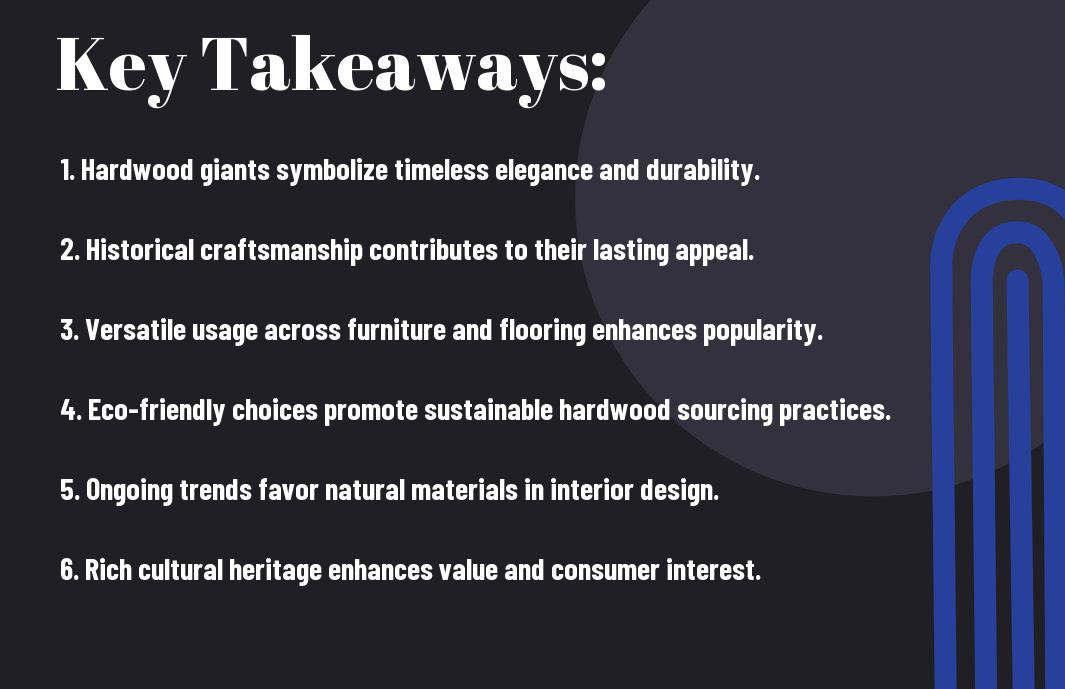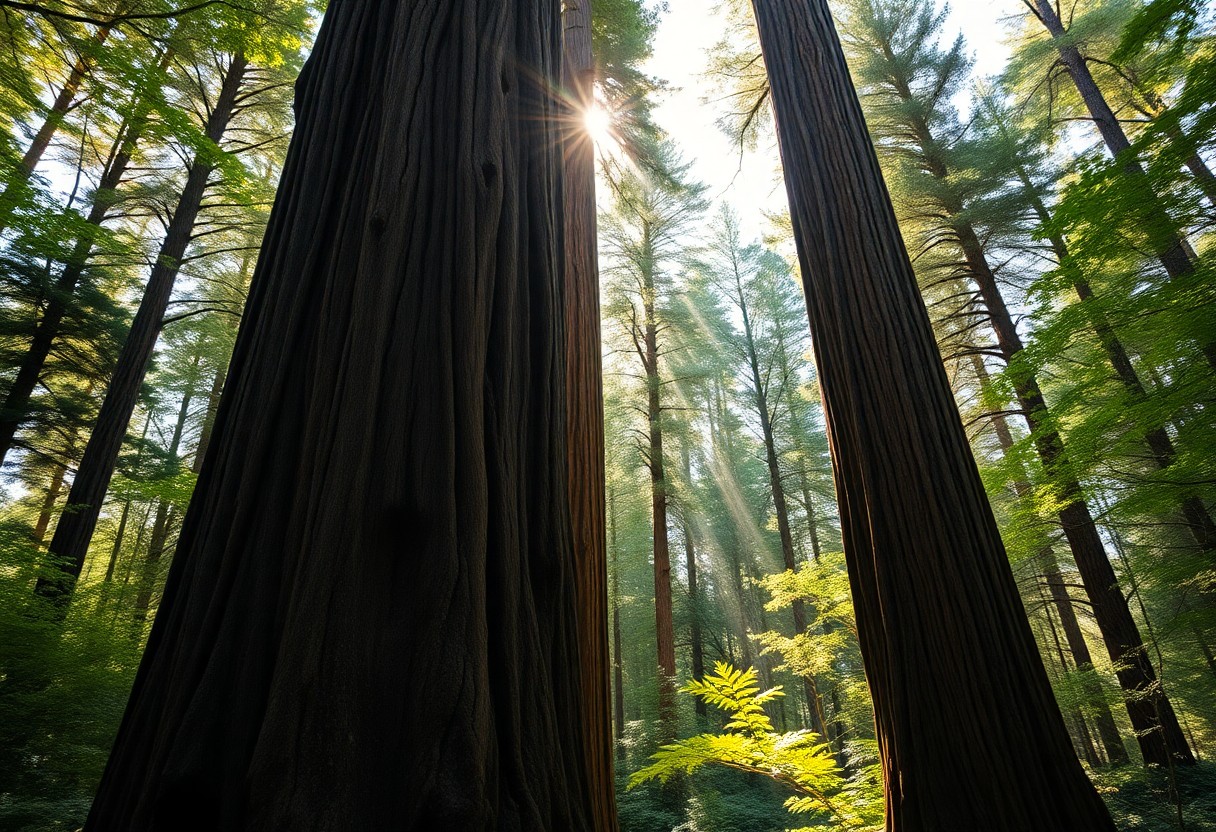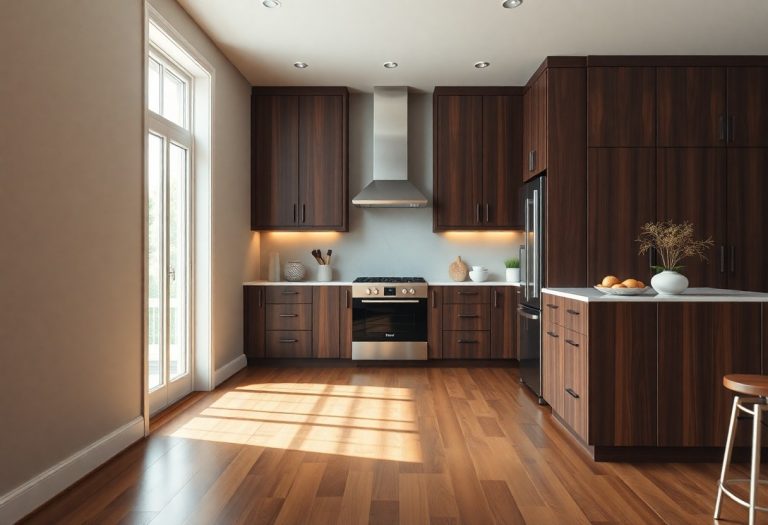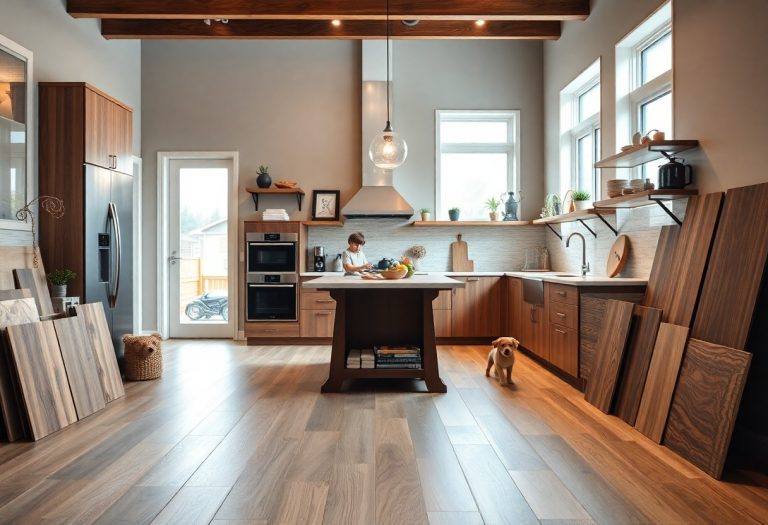You may find it fascinating to explore the historical significance of hardwood trees and their lasting appeal in various industries. As you explore into this topic, you’ll uncover how hardwood giants have shaped human culture, art, and architecture throughout the ages. From sturdy oak to elegant maple, these trees have not only provided crucial materials but have also influenced design trends and sustainability practices. Join us as we examine the reasons behind their timeless popularity and the role they continue to play in your world today.

The Historical Significance of Hardwood Trees
Before delving into the reasons hardwood trees have endured through time, it’s vital to recognize their historical significance. Across the globe, hardwood trees have played a paramount role in sustaining human civilizations, offering not only valuable materials but also playing a part in cultural practices and traditions. You will find that their robust nature and aesthetic appeal have made them a favorite choice for artisans, builders, and everyday individuals alike throughout history.
Origins and Evolution
On our planet, hardwood trees have evolved over millions of years, adapting alongside changing climates and landscapes. Certain species, such as oak, walnut, and cherry, have particular strength and density that make them particularly revered for construction and craftsmanship. Understanding the origins of these hardwood giants can deepen your appreciation for the resilience and versatility they exhibit, rooted in an evolutionary journey that shapes the forests we see today.
Cultural Uses Through the Ages
Around the world, hardwood trees have been integral to various cultures, standing as symbols of strength and longevity. From the grand cathedrals of Europe to the intricate furniture of Asia, hardwood has facilitated the expression of creativity and craftsmanship through the ages. You may be surprised to learn how these trees served not just practical needs but also formed cultural identities, contributing to rituals, artworks, and even governance.
Due to their remarkable durability and versatility, hardwoods have been used in crafting musical instruments, religious artifacts, and everyday tools, reflecting the diverse needs of society throughout history. As your understanding of hardwood trees grows, you will uncover the layers of meaning they carry in various communities, illustrating not just their functional significance but also their standing as a source of inspiration connecting generations. Their wood, revered for its beauty, contributes to both practical items and pieces of art that tell stories from ages past.
The Characteristics of Popular Hardwood Species
While each hardwood species possesses its unique traits, certain characteristics contribute to why species like oak, maple, and cherry are favored by many for various applications. One of the key attributes that set these hardwoods apart is their versatility; they adapt well to different styles of décor and serve multiple purposes. Additionally, their rich colors and grain patterns not only enhance aesthetic appeal but also create a sense of warmth and comfort in any setting.
Oak, Maple, and Cherry
An imperative part of the hardwood family, oak, maple, and cherry are celebrated for their outstanding qualities. Oak is renowned for its strength and durability, making it a favorite for furniture and flooring. Maple, often appreciated for its light color and subtle grain, lends a contemporary flair to any project. Cherry, with its deep tones that age beautifully, brings an elegant touch, often found in fine cabinetry and high-end furniture. Each of these woods offers something distinct, allowing you to choose the one that best fits your style and functional needs.
Density, Durability, and Aesthetics
With hardwood species, density and durability are paramount, particularly when selecting materials for furniture or flooring. You want wood that will withstand the rigors of daily life while still looking appealing over time. More than just being sturdy, aesthetics play a significant role in your selection process. The introduction of rich colors and unique patterns allows for customization in your design, satisfying both your practical needs and your personal taste.
Species like oak and maple have high-density ratings, which means they are not only durable but also resistant to scratches and dents, making them ideal for homes with heavy foot traffic. Cherry, while slightly softer, ages beautifully and can develop a patina that adds character to your surroundings. When evaluating hardwood for your projects, consider how each species meets your needs for density and durability while also enhancing your aesthetic vision, allowing you to create a space that truly reflects your personal style.

Economic Impact of Hardwood Industries
Now that you have a grasp on the significance of hardwoods in various aspects of life, it’s imperative to examine into their economic implications. Hardwood industries not only contribute notably to the domestic economy but also play an important role in global trade. The ongoing demand for hardwood products, ranging from furniture to flooring, showcases how these materials have sustained economic viability over decades, allowing communities to thrive and innovate. By understanding this economic framework, you can appreciate the lasting influence hardwoods have on market dynamics and industry growth.
Timber Production and Trade
With the flourishing timber production correlating directly to economic prosperity, hardwood farming has become an integral player in many regions. The trade of hardwood timber isn’t just a localized affair; it contributes to international markets as well. Countries rich in hardwood resources export significant quantities, creating a complex web of import and export dynamics that reflect the wood’s inherent value. This ongoing exchange not only bolsters national revenues but also fortifies international relationships rooted in commerce.
Job Creation and Local Economies
Hardwood industries are a vital source of employment that plays an indispensable role in sustaining local economies. You may find that in many rural areas, the hardwood sector supports forestry jobs, manufacturing positions, and even trades like woodworking and furniture design. The ripple effect of job creation extends far beyond the immediate industry, as workers spend their income in local businesses, spurring further economic activity and growth.
Production of hardwood goods often leads to an impressive number of jobs in associated sectors, from logging and transportation to retail and craftsmanship. This interconnectedness emphasizes how a single industry can uplift entire communities, highlighting the importance of sustainable practices in maintaining the health of both the hardwood market and your local economy. By fostering these industries responsibly, you are supporting not only your community’s job market but also contributing to a broader economic narrative that values and invests in the environment.
Environmental Considerations
Despite the enduring popularity of hardwood trees, it is crucial to consider their environmental impact. As you explore the allure of hardwoods for furniture, flooring, and other applications, you should also be aware of the larger ecological implications of harvesting these majestic giants. The balance of ecosystems can be disrupted by unsustainable logging practices, leading to habitat loss for wildlife and a decline in biodiversity. However, with increased awareness and responsible sourcing, you can contribute to a more sustainable future for hardwood forests.
Sustainability of Hardwood Forests
Considerations surrounding the sustainability of hardwood forests focus on logging practices and forest management. When you choose products made from sustainably harvested hardwood, you play a part in preserving these forests for generations to come. Sustainable forestry practices include selective cutting and replanting, which help maintain forest health while allowing for the procurement of timber. These practices ensure that hardwood trees can continue to thrive in their natural habitats while satisfying consumer demand.
Conservation Efforts
Sustainability efforts in hardwood forestry also extend to the ongoing conservation initiatives aimed at protecting these invaluable resources. To effectively preserve hardwood forests, various organizations and governments engage in initiatives that promote responsible forestry practices. These efforts often include establishing protected areas, encouraging reforestation projects, and implementing strict regulations on timber harvesting to prevent illegal logging. By supporting brands and products that align with these conservation goals, you can directly contribute to the longevity of hardwood resources and their ecosystems.
Contemporary Trends in Hardwood Usage
Many homeowners and interior designers are embracing hardwood for its timeless appeal and versatility. Contemporary trends highlight a growing preference for sustainably sourced hardwood options, offering both aesthetic value and environmental responsibility. As society increasingly focuses on eco-friendly materials, you may find that many hardwood suppliers are now prioritizing sustainable harvesting techniques. This shift not only allows you to enhance your living spaces but also supports conservation efforts and promotes responsible forestry practices.
Residential and Commercial Applications
Usage of hardwood in residential settings has significantly evolved, incorporating a broad range of styles and finishes to meet diverse preferences. From stunning hardwood floors that exude warmth to elegant cabinetry and furniture, hardwood is adaptable to various decor styles, allowing you to create inviting atmospheres in your home. In commercial applications, hardwood continues to gain traction, particularly in high-end restaurants, retail spaces, and offices, where it conveys a sense of luxury and sophistication that appeals to customers and clients alike.
Innovations in Design and Functionality
For designers, the emergence of innovative techniques in hardwood usage has transformed traditional applications into modern masterpieces. New treatment methods allow you to choose from a variety of textures and colors, accommodating different aesthetic requirements while maintaining the natural beauty of wood. You might also notice a surge in hybrid materials that blend hardwood with other substances, enhancing durability and functionality, making them suitable for high-traffic areas or even outdoor spaces.
Innovations in hardwood design extend beyond mere aesthetics; they embody a thoughtful approach to enhancing everyday functionality. Advanced finishing techniques make hardwood more resistant to scratches, water damage, and wear, ensuring that your investment stands the test of time. Additionally, engineered hardwood options provide the opportunity for superior moisture resistance while maintaining the desired look of solid wood, making it an ideal choice for areas with fluctuating humidity levels. The evolving landscape of hardwood applications demonstrates how these materials can meet modern demands while preserving their intrinsic beauty and value.
Consumer Preferences and Market Demand
Not only is the appeal of hardwood giants primarily aesthetic, but it is also influenced by a range of factors that shape your preferences as a consumer. The quality and durability of hardwood flooring and furniture make them highly sought after, creating a lasting investment for your home. The natural beauty of hardwood, with its warm tones and unique grain patterns, often fits seamlessly into various design themes, from rustic to contemporary. Additionally, many consumers find themselves attracted to sustainable and environmentally friendly choices, which further boosts the popularity of responsibly sourced hardwood.
Factors Influencing Popularity
To understand the enduring appeal of hardwood products, it’s important to examine the various factors that influence your purchasing decisions. These may include:
- Quality perception: Many associate hardwood with reliability and longevity, making it a preferred choice.
- Versatility in design: Hardwood fits numerous aesthetic preferences and complements a variety of interior styles.
- Sustainability: A growing emphasis on eco-friendly products leads you to seek out responsibly harvested materials.
- Resale value: Homes with hardwood floors tend to sell at higher prices, appealing to your long-term investment perspective.
Perceiving these aspects as significant benefits encourages you to choose hardwood over other flooring and furniture options, reinforcing its demand in the market.
Trends in Consumer Choices
By analyzing current market trends, you can identify shifts in consumer preferences that influence your choices for hardwood products. The rising awareness around sustainability has led to an increase in demand for reclaimed and recycled wood, as consumers become more conscientious about their environmental impact. Additionally, innovations in design and finishes have made hardwood more accessible and appealing, allowing for customization that resonates with your personal style.
In fact, the increasing popularity of minimalist and open-concept home designs has sparked a demand for lighter-toned woods and wider planks, while also fostering an inclination for natural finishes that accentuate wood’s inherent beauty. This shift in preferences showcases a desire for spaces that exude warmth and elegance, helping to ensure that hardwood remains a top choice. As you explore current trends, you will likely find that consumer interest in hardwood giants persists, making them an enduring staple in home design.
To wrap up
Conclusively, as you explore the historical significance of hardwood giants, you come to appreciate their deep-rooted presence in various cultures and homes. These majestic trees have not only provided sustenance and shelter but have also shaped your experiences through the materials crafted from their timber. From crafting furniture that becomes the centerpiece of your living space to the artwork that inspires conversation, hardwoods embody a blend of natural beauty and functionality that is hard to rival.
As you consider the enduring popularity of hardwoods in contemporary society, it becomes evident that their appeal is anchored in both practicality and aesthetics. Your understanding of this rich history empowers you to make informed choices in your selections, whether you are furnishing your home or choosing sustainable practices for future generations. Embracing these hardwood giants means honoring their legacy while ensuring they continue to play a vital role in your life and community.





